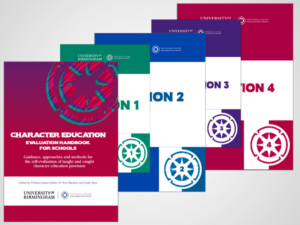The Character Evaluation Handbook for Schools provides a practical introduction to the evaluation of character education in primary and secondary schools. It:
- Provides advice, guidance and tools to enable schools to implement the principles and practice of self-evaluation to enhance and improve their character education provision;
- Is intended to be a source of inspiration that schools should adapt to their own context;
- Is based on the premise that by using varied forms of self-evaluation teachers can develop a holistic and formative picture of their school’s character-education profile; and
- Is designed to support the recent movement in schools to self-evaluate their own practice. School-led approaches to self-evaluation are now commonplace in most schools, including the Ofsted framework whereby inspectors often use the outcomes from self-evaluation as the starting point for their inspections.
- Is comprised of an introduction and four sections each investigating various strategies and benefits of evaluation.
Contents Overview
Section 1: Planning an Evaluation – An introduction to self-evaluation which outlines important principles, limitations, and procedures. It also provides an overview of the nature of character and character education. It is important to read this section before planning an evaluation
Section 2: Character Caught – A framework for schools to evaluate their whole school character education provision. The primary and secondary frameworks should be used ass a best-fit model and schools should adapt the frameworks to meet their needs.
Section 3: Character Taught – The different approaches and methods that could be used to self-evaluate formal or non-formal curriculum interventions, strategies, and activities designed to develop character. Starting with a general overview of the nature and use of self-evaluation methods and instruments, there are sub-sections on the use of surveys and self-report scales, observations of lessons, group interviews, and dilemmas.
Section 4: Student Self-Reflection – How student’s self-reflection can support the development of character and more specifically practical wisdom. This section includes examples of different schools’ approaches to student self-reflection on character.

